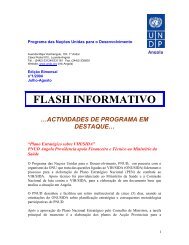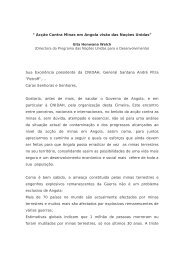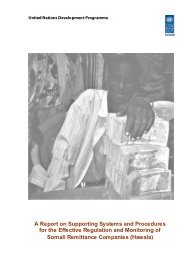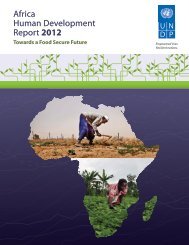CORRUPTION AND ANTI-CORRUPTION STRATEGIES ... - UNDP
CORRUPTION AND ANTI-CORRUPTION STRATEGIES ... - UNDP
CORRUPTION AND ANTI-CORRUPTION STRATEGIES ... - UNDP
You also want an ePaper? Increase the reach of your titles
YUMPU automatically turns print PDFs into web optimized ePapers that Google loves.
surrounding the government's purchase of<br />
school textbooks (which involved a loss of<br />
US$ 15.0 million), land distribution and<br />
housing management. The scandals led to<br />
three Presidential Commissions of Inquiry<br />
in 199l and 1992, which revealed that those<br />
involved were amongst the highest paid in the<br />
land. These instances of the relatively rich<br />
becoming richer through corruption are<br />
contrary to the view that much African<br />
corruption is a crime perpetrated by the poorly<br />
paid. An over-dominant ruling party in<br />
Botswana had undermined Democratic<br />
safeguards against corruption, as well as<br />
traditional forms of accountability.<br />
Subsequently, the government established a<br />
Directorate of Corruption and Economic Crime<br />
(DCEC) in 1994, which has reported annually<br />
to parliament. These developments reflect a<br />
political commitment to tackle the issue,<br />
with evidence of the commitment seen in the<br />
number of cases investigated by the DCEC,<br />
the number of cases put to the courts, and the<br />
number of convictions. The DCEC's 1996<br />
Report pointed out that “earlier hypotheses<br />
that corruption existed in many spheres and at<br />
all levels in both Government and Local<br />
Government ... have proved correct”. Like<br />
Hong Kong's anti-corruption strategy,<br />
Botswana's DCEC has developed a threepronged<br />
attack with a focus upon investigation<br />
and prosecution, public education and prevention.<br />
Frimpong concluded his argument by suggesting<br />
that any effective fight against corruption in<br />
developing countries has to involve international<br />
collaboration because of the impact of MNC's<br />
and trade and other economic interdependence.<br />
Ecuador<br />
Dr. Ramiro Larrea-Santos (Larrea-Santos, 1997)<br />
spoke on his role as the Chairman of the Anti-<br />
Corruption Commission of Ecuador. The Anti-<br />
Corruption Commission was created in March<br />
1997 with the intention of channelling civil<br />
society activities into the uncovering, investigation<br />
and surveillance of corruption. The results of<br />
the Commission's work would be handed over<br />
to the legislative and judicial elements of the<br />
Ecuadorian state. The Commission’s operations<br />
would run until August 1998 and had recently<br />
developed a draft law to institutionalise itself.<br />
The pernicious effects of corruption in Ecuador<br />
had threatened the very stability of its democracy.<br />
Corruption was tied to some of the state's<br />
recent political dramas, including the uprising<br />
of the Ecuadorian people against the previous<br />
regime of Abdala Bucaram in February 1997.<br />
Many state activities under the old regime<br />
were affected by corruption: these included the<br />
customs and tax services, public building and<br />
other public contracts. It contributed to a<br />
completely inadequate service provision, and<br />
the politicisation of public finance and justice.<br />
Public contracts involved bribes of between<br />
10% and 30%, while electricity blackouts of<br />
up to eight hours a day were in part a product<br />
of corruption. Customs duty evasion was massive,<br />
estimated at Sucres 210bn in six months. Dr.<br />
Larrea-Santos listed fourteen “main causes” of<br />
corruption and eleven 'most visible effects' of<br />
corruption in Ecuador. The main causes were a<br />
breakdown in ethical values, illiteracy and a nontransparent,<br />
politicised and over-centralised<br />
state. The most visible effects were violence<br />
and a sense of resignation about the effects of<br />
corruption, poor public services and increasing<br />
social polarisation and exclusion. A large<br />
number of anti-corruption initiatives in the<br />
legal, educational and social realms were under<br />
way at present, including the creation of new<br />
legal anti-corruption mechanisms, public education<br />
activities, and the investigation and<br />
prosecution of public officials from the Bucaram<br />
regime. Popular participation and civic awareness<br />
through civil society organisations were important<br />
elements in an anti-corruption strategy but,<br />
while it was recognised that educational and<br />
social issues (such as the reduction of illiteracy)<br />
were valuable, they were often long-term in<br />
impact. What was important was the identification<br />
of effective, short-term remedies.<br />
<strong>CORRUPTION</strong>& INTEGRITY IMPROVEMENT INITIATIVES IN DEVELOPING COUNTRIES<br />
5 1







